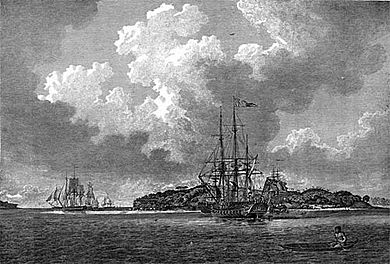Charlotte (1784 ship) facts for kids
Quick facts for kids History |
|
|---|---|
| Name | Charlotte |
| Owner |
|
| Port of registry | London |
| Builder | Thames |
| Launched | 1784 |
| Fate | Possibly sunk November 1818; disappears from lists in 1821 |
| General characteristics | |
| Tons burthen | 335, or 338, or 34553⁄94, or 350, or 384 bm |
| Length | 105 ft (32 m) |
| Beam | 28 ft 3 in (8.61 m) |
| Sail plan | Full-rigged ship |
| Crew | 30 |
| Armament | 8 × 18-pounder carronades |
| Notes | Barque-built (1786) |
The Charlotte was an English merchant ship built on the River Thames in 1784. She became famous for being part of the First Fleet. This fleet carried convicts to New South Wales (now Australia) in 1788.
After dropping off the convicts, she sailed to China. There, she picked up goods for the East India Company before returning to Britain. For many years, Charlotte then worked as a cargo ship. She mainly sailed between London and Jamaica. The ship might have been lost near Newfoundland in 1818. In any case, she was no longer listed as active by 1821. Charlotte even appeared in the movie National Treasure.
Contents
The Ship's Early Journeys
The Charlotte first appeared in Lloyd's Register in 1784. This register is like a record book for ships. Before her big voyage with convicts, Charlotte traded with places like the Baltic Sea and the West Indies.
| Year | Master | Owner | Trade | Source |
|---|---|---|---|---|
| 1784 | Sanderson | Matthews | London–Petersburg | LR |
| 1786 | J.Sanderson | Matthews | London–Antigua | LR |
| 1787 | J.Sanderson Tho. Gilbert |
Matthews | London–Stettin London–Botany Bay |
LR |
| 1789 | T.Gilbert | Matthews | London–Botany Bay | LR |
Charlotte and the First Fleet
The Charlotte was known for being a "heavy sailer." This meant she was slow. She even had to be towed down the English Channel. This helped her keep up with the other ships in the First Fleet.
Her captain was Thomas Gilbert. The ship's surgeon was John White. He was the main surgeon for the new colony. During the voyage, they found out their third mate had been left behind. Another sailor from a nearby naval ship quickly took his place.
The Charlotte carried 84 male and 24 female convicts. Some sources say it was 88 male and 20 female convicts. Famous convicts like James Squire and Mary Bryant were on board. The ship also carried 42 soldiers. These soldiers from the New South Wales Marine Corps guarded the convicts.
The Charlotte arrived at Port Jackson, Sydney, Australia, on 26 January 1788. This date is very important in Australian history. A special medal, called the Charlotte Medal, was made to remember this voyage. Surgeon White ordered it, and a convict named Thomas Barrett created it.
Journey to China and Discoveries
After dropping off the convicts, Charlotte left Port Jackson on 6 May 1788. She was headed for China. Her job was to pick up a cargo of tea for the East India Company.
In May 1788, Captain Gilbert of Charlotte and Captain John Marshall of the ship Scarborough sailed together. They wanted to find a new route to China. On their journey, they discovered several islands. These included Lord Howe Island and Norfolk Island.
Later, on 27 May 1788, they found Matthew Island. On 24 June, they saw land in the southern Marshall Islands. They continued past many other islands. These included Abemama, Kuria, Aranuka, Tarawa, Abaiang, Butaritari, and Makin. They did not try to land on these islands.
They finally reached Canton (now Guangzhou, China) on 9 September 1788. The trip from Port Jackson took 126 days. The two large groups of islands they discovered are now known as the Gilbert and Marshall Islands.
Charlotte's Later Years
When Charlotte returned to England on 28 November 1789, a company called Bond and Co. bought her. They wanted to use her for trade between London and Jamaica. This was a busy shipping route.
The table below shows some of her later voyages:
| Year | Master | Owner | Trade |
|---|---|---|---|
| 1790 | T. Gilbert B. Howes |
Matthews Bond & Co. |
London–Botany Bay London–Jamaica |
| 1795 | Kent | Bond & Co. | London–Jamaica |
| 1800 | D. Kent | Rutherford | London–Jamaica |
| 1805 | D. Kent | Rutherford | London–Jamaica |
In 1806, Charlotte was part of a military expedition. This group, led by General Sir David Baird, captured the Dutch Cape Colony (in modern-day South Africa).
Later, in 1807, Charlotte sailed to France. She carried prisoners from a French ship called Volontaire.
| Year | Master | Owner | Trade | Source & notes |
|---|---|---|---|---|
| 1807 | R.Allison | Fletcher | London transport | LR; repairs 1804 |
| 1810 | R.Allison | Fletcher | London transport | LR; repairs 1804, & good repair 1804 |
| 1819 | R. Allison | Fletcher | London transport | LR; good repair 1810 |
The End of Charlotte's Journey
A ship named Charlotte was lost near Newfoundland in November 1818. This ship was sailing from Quebec to Liverpool. However, it is not certain if this was the same Charlotte from the First Fleet.
Some records show that Charlotte was still listed in Lloyd's Register until 1821. But sometimes, these old lists kept ships on them even after they were no longer active. So, the exact end of the Charlotte's story is a bit of a mystery.
Remembering Charlotte
In 1986, a First Fleet-class ferry in Australia was named after the Charlotte. This was a way to remember her important role in history.


